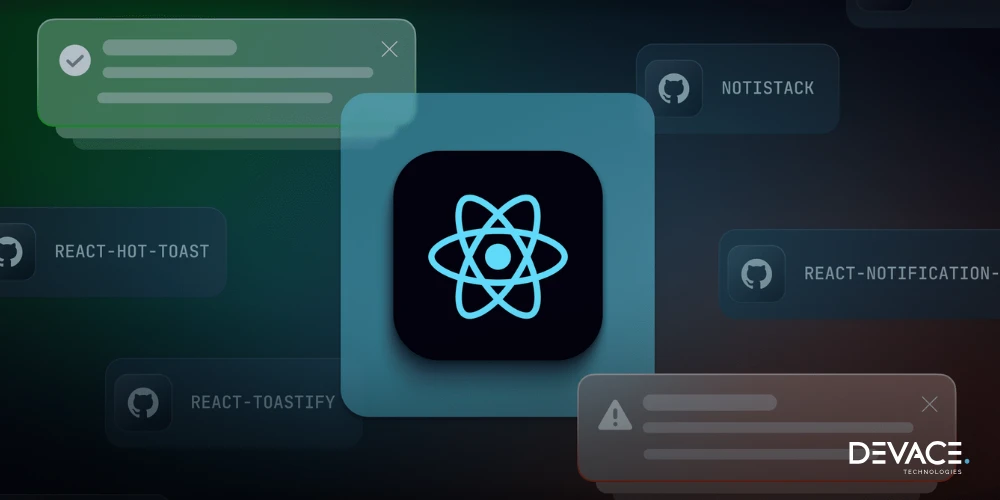So if you’re wondering why use React, the answer is pretty simple: Its component-based architecture, fast rendering with virtual DOM, and rich ecosystem make it the go-to choice for modern web development.
This article will guide you on React best practices that every good developer follows in 2025. From project structure and clean code to TypeScript integration and testing strategies, these best practices in React will make sure your code always comes out on top. That’s because following React best practices is crucial if you want to build scalable, maintainable, and high-performance applications.
React Best Practices
When building a React application, following React and React JS best practices is key to ensuring scalability, performance, and maintainability for your app. And if you’re looking to hire React JS developers, make sure they’re familiar with these best practices so that you get high-quality and efficient code.
-
Adhere to Naming Conventions
Good developers use common naming conventions to more easily recognize what type of element they’re dealing with and to have something in their code that is common in the community.
Naming conventions in React help maintain consistency and clarity in the code. By following a pattern, you make it easier for others (and future you) to understand the purpose of each component, function, or variable.
The two most common types are camelCase for variables and functions; and PascalCase for components.
For example, naming a component UserProfile rather than userProfile makes it clear that it’s a React component. Use a Consistent Import Order
As your React app grows, you’ll inevitably have to add more and more imports. Keeping your import structure organized can really help you understand what makes up your components.
One of the best practices in React is to group similar utilities together. For example, keep the third-party imports separate from the local ones. This will makes things easier to navigate like this:
// Third-party imports
import React from 'React';
import { useState } from 'React';
import axios from 'axios';
// Local imports
import { Header } from './components/Header';
import { Footer } from './components/Footer';
import { formatDate } from './utils/formatDate';
The third-party imports like React, useState, and axios are grouped together at the top, followed by the local imports such as Header, Footer, and formatDate. This structure helps you quickly see which libraries you’re using and which components or utilities are specific to your project.
Organizing imports in a consistent order improves the readability and makes managing dependencies easier for you or your team. A standard order you can follow is: external libraries, internal modules, components, and then styles.
-
Use Functional Components and Hooks
Modern React development encourages the use of functional components over class-based ones. Combine them with React hooks like useState, useEffect, and useMemo to manage state and side effects efficiently. Hooks in React let you interact with your component’s state and run after-effects in relation to certain state changes in your component, all without having to write class components.
Not only are they cleaner, but they also integrate seamlessly with React hooks like useState, useEffect, and useMemo. Here’s an example of a custom hook:
// hooks/useUserStatus.js
import { useEffect, useState } from 'React';
export function useUserStatus(userId) {
const [isOnline, setIsOnline] = useState(false);
useEffect(() => {
const unsubscribe = subscribeToUserStatus(userId, setIsOnline);
return () => unsubscribe();
}, [userId]);
return isOnline;
}
Now here’s how it cleans up your code when used in a component:
import { useToggle } from '../hooks/useToggle';
function ToggleButton() {
const [isOn, toggle] = useToggle();
return (
<button onClick={toggle}>
{isOn ? 'ON' : 'OFF'}
</button>
);
}
React hooks best practices, like using hooks such as useState and useEffect efficiently while avoiding side effects within the render phase, will improve the readability and performance of your React components across your app.
So, if a logic block interacts with state or effects and could be reused—or it just clutters the component—simply move it into a custom hook. Remember to keep the hook in a dedicated hooks/ folder within the relevant feature.
-
Extract Reusable Logic into Custom Hooks
Another of the best practices for React JS is creating custom hooks. If you notice the same logic appearing across multiple components, like syncing to local storage or handling window resize, that means it’s time to abstract it into a custom hook. This makes your code more readable, testable, and consistent.
So keep in mind that if there is any stateful logic that’s repeating itself across different components, that’s your cue to create a custom hook. Wrap that logic in a function, give it a name that makes sense, and use it wherever needed to keep your components clean and your codebase that much easier to read and use.
Here’s an example of a useToggle custom hook. Like a reusable function, it helps you toggle a true/false value (or boolean) that can come in handy when, for example, you have something you want to show or hide (like a modal or a dropdown). The useToggle hook makes it easy to manage that behavior:
import { useState } from 'React';
function useToggle(initialValue = false) {
const [value, setValue] = useState(initialValue);
const toggle = () => setValue((prev) => !prev);
return [value, toggle];
}
export default useToggle;
//usage in a component
import useToggle from './hooks/useToggle';
function ModalExample() {
const [isOpen, toggleModal] = useToggle();
return (
<div>
<button onClick={toggleModal}>
{isOpen ? 'Close Modal' : 'Open Modal'}
</button>
{isOpen && <div className="modal">Hello, I'm a modal!</div>}
</div>
);
}
-
Write Clean, Reusable Code
An easy way to remember this one is to follow the DRY (Don’t Repeat Yourself) principle.
Think in components. If a part of your UI can be reused in more than one place, just break your UI into small, reusable components. Use meaningful variable names and avoid any side effects inside components. Use prop destructuring, default props, and meaningful naming conventions to improve code clarity.
Here’s an example of a reusable loading spinner you can use for multiple web pages and then how it can be used in your codebase:
// components/Spinner.jsx
export default function Spinner() {
return <div className="spinner">Loading...</div>;
}
// usage
{isLoading ? <Spinner /> : <Content />}
Follow writing clean React code principles like consistent formatting, avoiding deeply nested components, and documenting prop types to make the code easier and better-prepared for any future edits.
-
Organize Project Files Logically
A messy file structure slows down collaboration and scalability. Adopt React folder structure best practices like this one:
src/ ├── features/ │ ├── auth/ │ │ ├── components/ │ │ ├── hooks/ │ │ ├── services/ │ │ └── AuthPage.jsx ├── shared/ │ ├── components/ │ └── utils/
The above is the feature-based folder structure, where each feature has its own components, styles, tests, and hooks. This type groups files in a folder according to their routes and features, helping to keep everything about a particular feature in one space. And it makes it easier to locate files, onboard new developers, and test features in isolation.
The second is the type-based folder structure, which groups files by type across the entire app—like putting all components, styles, and hooks in their own global folders. Here’s what that looks like:
src/ ├── components/ │ ├── Dashboard.jsx │ └── Home.jsx ├── styles/ │ ├── Dashboard.css │ └── Home.css ├── hooks/ │ ├── useAuth.js │ └── useFetch.js
Whatever type you choose or your team prefers, remember to always structure your project to be scalable. Following a clear folder hierarchy is part of React project structure best practices, helping teams scale, maintain, and debug apps more efficiently.
-
Use Snippet Libraries
Snippet libraries do wonders to speed up your development process. One of the most popular best practices for React JS, these are pre-written, reusable code blocks that you can insert directly into your codebase. Tools like VS Code Snippets or Emmet offer predefined templates for common patterns. Or you can use VSCode extensions like ES7+ React/Redux/React-Native snippets. Here’s what happens when you type rfce:
import React from 'React';
function MyComponent() {
return <div>MyComponent</div>;
}
export default MyComponent;
It saves time, reduces typos, and helps you stay in the flow—especially during repetitive coding tasks. This is particularly useful for repetitive code like form inputs, button components, or even hooks.
-
Use a Linter
A linter is a tool that automatically checks your code for any syntax or style issues, improving code quality and helping with consistency.
It does this by enforcing coding standards across your project which is particularly useful when working in teams to make sure that everyone adheres to the same code style through the React development.
Tools like ESLint can be configured to enforce rules like indentation, variable naming, and even preventing unused imports. It observes your code and then notifies you when a rule has been broken. The keyword or line that breaks the rule would usually be underlined in red.
Using a linter saves time during code reviews, improves overall code quality and makes sure of code uniformity especially when there’s a team of developers working on the same code.
-
Optimize Performance with Lazy Loading
As your React app grows, so does your bundle and codebase size, which will definitely slow things down in the long run.
By default, React loads the entire application at once, which isn’t always ideal for performance. That’s where lazy loading (also known as code splitting) comes in. Lazy loading lets you defer certain loading parts of your app until they’re actually needed. Instead of loading every single component upfront, you can split your code into smaller bundles and load only what the user requires at that given moment.
For example, the sign-in logic can load first, and then the dashboard code can follow only after the user logs in. Take a look at this example:
// App.jsx
import React, { Suspense, lazy, useState } from "React";
import SignIn from "./SignIn";
// Lazy load the Dashboard component
const Dashboard = lazy(() => import("./Dashboard"));
function App() {
const [isLoggedIn, setIsLoggedIn] = useState(false);
return (
<div>
{isLoggedIn ? (
<Suspense fallback={<div>Loading dashboard...</div>}>
<Dashboard />
</Suspense>
) : (
<SignIn onLogin={() => setIsLoggedIn(true)} />
)}
</div>
);
}
export default App;
// SignIn.jsx
export default function SignIn({ onLogin }) {
return (
<div>
<h2>Sign In</h2>
<button onClick={onLogin}>Login</button>
</div>
);
}
// Dashboard.jsx
export default function Dashboard() {
return <h2>Welcome to the Dashboard!</h2>;
}
In this example, the Dashboard component is lazy-loaded. It only gets fetched and rendered after the user logs in. This way, the initial load focuses only on what’s needed, improving performance for your React app. This technique improves load time, reduces initial data usage, and gives users a faster, smoother experience, especially on larger apps or apps you intend to scale later on.
-
Implement Effective React Unit Testing
Testing your code during development is important if you want your code to create maintainable and high-quality apps.
While some developers overlook this part, testing has many advantages: It helps detect errors early, improves code quality, and can save you money by catching bugs early on.
To make sure that your React components are functioning the way they should, adopt React testing best practices like testing user interactions with tools like React Testing Library. These can help with testing by writing meaningful tests that simulate user interactions, so choose the one that works best for you.
Here’s an example of how to test a simple React component using the React Testing Library:
render(<LoginForm />);
fireEvent.change(screen.getByLabelText(/email/i), { target: { value: 'test@test.com' } });
expect(screen.getByLabelText(/email/i)).toHaveValue('test@test.com');
With React unit testing, you can simulate real user behavior, like filling out a login form, and assert expected outcomes using tools like React Testing Library. Just remember to focus on testing behavior rather than implementation details to ensure your components behave as expected, even as your application grows.
-
Use TypeScript
Adding TypeScript to your React project helps catch bugs early and improves developer productivity.
It adds static typing to JavaScript, which helps you catch errors early in development, preventing any bugs before they even make it to the runtime. With features like type inference and interfaces, TypeScript ensures your components get the right data and reduces the chances of unexpected behavior. Here’s an example of what that would look like in your codebase:
// types.ts
export interface User {
id: number;
name: string;
email: string;
}
// UserCard.tsx
import React from 'React';
import { User } from './types';
type Props = {
user: User;
};
const UserCard: React.FC<Props> = ({ user }) => {
return (
<div>
<h3>{user.name}</h3>
<p>ID: {user.id}</p>
<p>Email: {user.email}</p>
</div>
);
};
export default UserCard;
This example defines a User interface separately and uses it in the Props type for a clean, scalable setup.
It’s a powerful tool for making your code more predictable and easier to scale as your app grows. If you’re building something bigger, TypeScript should definitely be part of your workflow. So be sure to follow TypeScript React best practices such as using typing props and state properly, using interfaces for reusable types, and adding enums where appropriate.
-
Use Component Libraries and Utilities
A good rule of thumb is to use popular React component libraries like Material UI, Chakra UI, or Tailwind to speed up development and ensure UI consistency.
Using Component Libraries (like Material UI, Chakra UI, or Ant Design) is one of the top React best practices because it promotes consistency, saves development time, and makes sure that your UI components are well-tested and optimized for accessibility and responsiveness.
These libraries provide a set of pre-built, styled components that you can integrate into your app, allowing you to focus more on the functionality aspect rather than building everything from scratch. They also improve collaboration between teams because they offer consistent UI patterns.
For example, instead of writing custom modals, you can use Chakra’s:
import { Modal, ModalOverlay, ModalContent } from '@chakra-ui/React';
To take things a step further, if you prefer custom styles, use CSS-in-JS solutions like Styled Components or Emotion to combine styling and logic in your components. You end up with a seamless and maintainable codebase since both approaches help maintain consistency and reduce the time spent on UI design.
-
Stay up-to-date with React Version Updates
Like any other technology, React is constantly evolving. From introducing powerful hooks like useTransition to optimizing rendering with Concurrent Mode, there will always be a new release that brings something that can either make or break your code. That all depends on how well you keep up.
That’s why staying updated means your app stays secure, performs better, and avoids any deprecated APIs that could silently fail down the development road.
You can stay in-the-know by following the official React blog for release notes and migration tips or join the React GitHub Discussions to see what changes are coming down the pipeline. Periodically run npm outdated to catch any version drifts in your dependencies and use tools like React-codemod to help refactor all the old patterns automatically.
These updates keep your codebase fresh, manageable, and aligned with how React is meant to be used today, which is both great for you and the clients you’re building your app for.
Build React Applications with Devace Technologies
Following React best practices will help you scale your frontend team or build high-quality web applications without hassle.
But to save more time and get the right expertise for the job, you can reach out to Devace Technologies to help you get started. We implement proven React and React JS best practices to build scalable applications, all while following strict testing protocols.
Conclusion
Following React best practices is more than just a set of rules, it’s a series of habits that you can learn to improve not only your coding skills but also your code quality. It reduces bugs and ensures long-term maintainability every time you build an app. Whether it’s organizing files, writing tests, or managing state, these practices form the foundation of scalable applications prepared for any future criteria.
So when you’re building your next web app with React, keep these best practices in mind to make using and managing your app easy for both your users and your team of developers.
Frequently Asked Questions
What are the best practices for handling state updates in React?
Use useState for simple, local state and useReducer when the logic gets more complex or involves multiple related state values. Remember to always treat the state as immutable. Never mutate it directly. To avoid bugs, use the functional form of the updater for updates that depend on the previous state.
What are the best practices for writing clean React code?
Use meaningful variable and component names, avoid deeply nested ternary expressions, and extract shared logic into custom hooks. Keep the components focused: ideally, one function per concern. Also, avoid putting side effects inside render logic. These changes will improve the readability and maintainability of your code and make collaboration across teams much easier.
What are the most common performance issues in React apps?
The most common performance issues in React apps are: unnecessary re-renders, unoptimized component structures, and bloated bundle sizes. Forgetting to use keys in lists, overusing context or state, or running expensive operations inside useEffect without proper dependencies can also drag things down. To keep your app running fast, use tools like React.memo, lazy loading, and code-splitting. And always keep an eye on what needs to be re-rendered.
Is it best practice to use Redux in every React project?
No. Only use Redux if your app has complex state logic. For simpler apps, context API or local state is often sufficient for your needs.
How can I make my React app more scalable?
To make your React app more scalable, focus on structure and separation. Organize your code by feature or by type. Extract logic into custom hooks and utilities, use TypeScript for type safety, and create reusable components. Also, stick to clear naming conventions and use a consistent folder structure. Writing unit tests, documenting shared components, and setting up linting and formatting tools will also help your app grow.
What are the best practices for handling form submissions in React?
Use controlled components, validate input on change/submit, and manage form state using hooks or libraries like Formik or React Hook Form.






